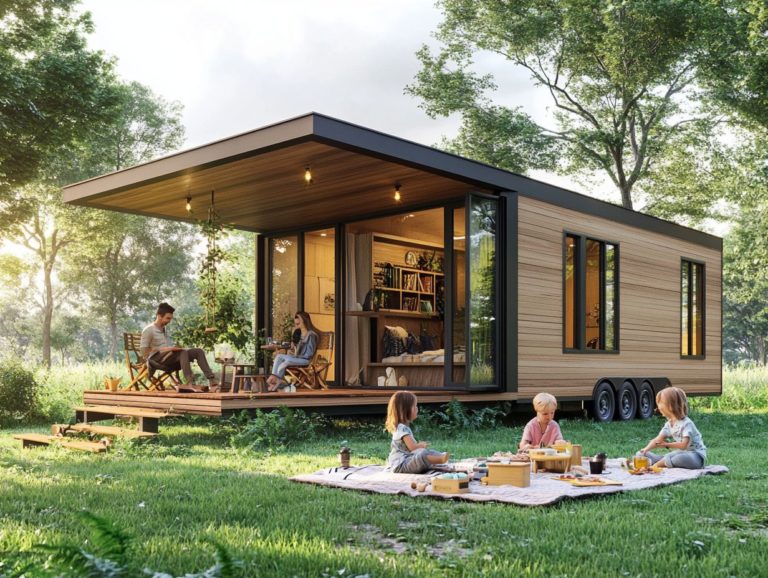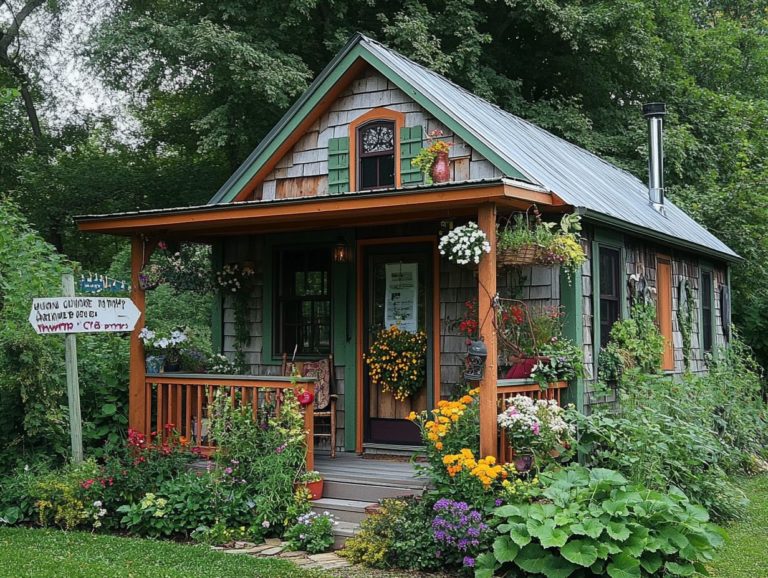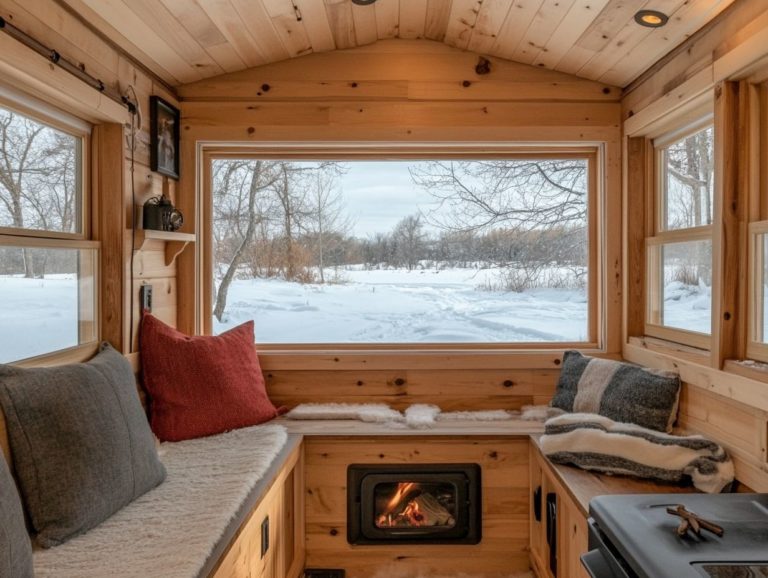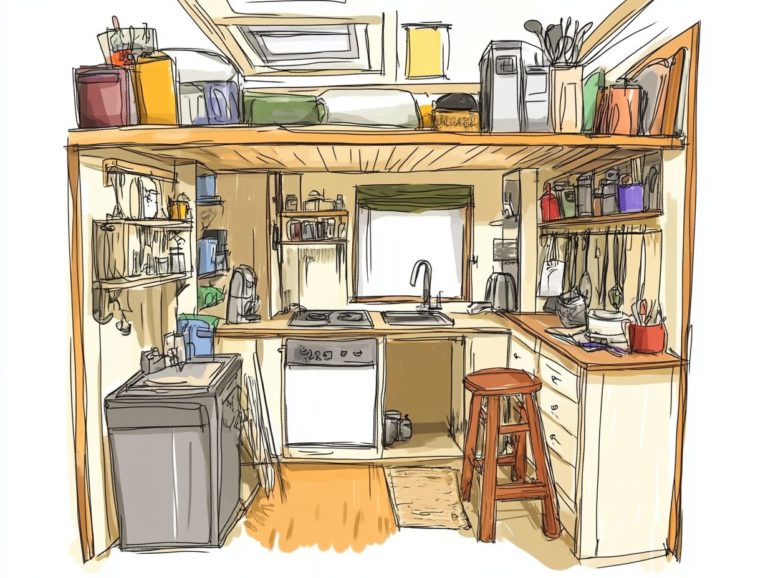How to Downsize My Belongings for a Tiny House?
The allure of tiny houses and the growing trend to downsize is captivating, drawing in minimalists and eco-conscious individuals alike.
But what does it truly mean to live in a tiny house? This article delves into the essence of tiny living, exploring the myriad benefits it offers and why downsizing is a fundamental aspect of this lifestyle, including emotional adjustments and lifestyle changes.
From grasping the realities of limited space to practical strategies for decluttering, you ll be guided through the journey of letting go of excess belongings and maximizing your newfound, cozy environment.
Are you ready to embrace a simpler, more intentional way of living? Let s embark on this transformative journey together!
Contents [hide]
- Key Takeaways:
- Understanding Tiny Houses
- Why Downsizing is Necessary for a Tiny House
- Steps to Downsizing for a Tiny House
- Tips for Letting Go of Belongings
- Frequently Asked Questions
- How do I determine what to keep and what to get rid of when downsizing for a tiny house?
- What are some tips for maximizing storage space in a tiny house?
- How can I downsize my wardrobe for a tiny house?
- What should I do with sentimental items when downsizing for a tiny house?
- How can I make the downsizing process less overwhelming?
- What are some common mistakes to avoid when downsizing for a tiny house?
Key Takeaways:
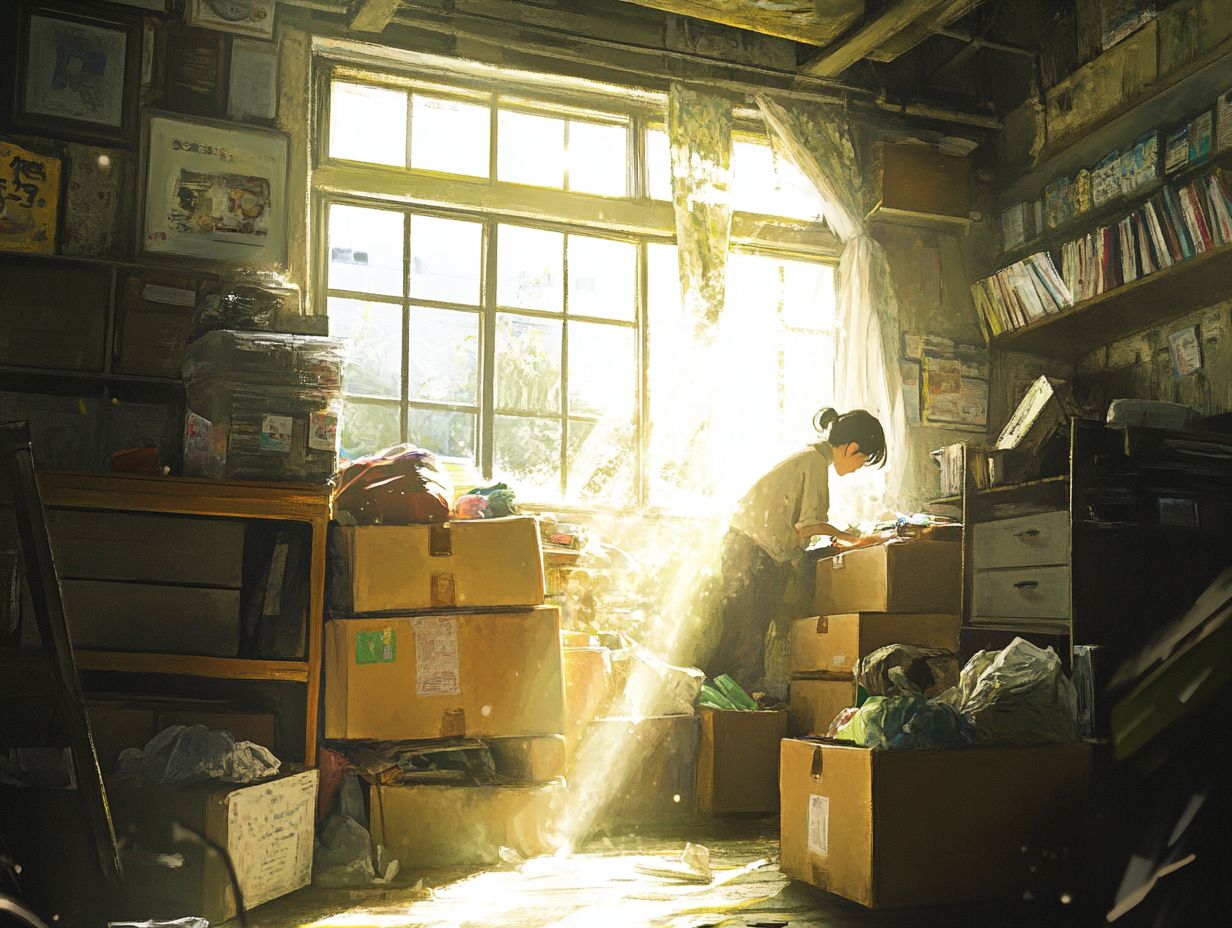
- Understand the concept of tiny houses and the benefits of living in one.
- Recognize the necessity of downsizing for a tiny home due to space and financial limitations, emphasizing space efficiency.
- Follow a step-by-step process of assessing, decluttering, and organizing belongings for maximum space and storage solutions.
Understanding Tiny Houses
Understanding tiny houses invites you to explore a captivating concept: a diminutive living space that champions a minimalist lifestyle. This approach encourages you to reduce clutter, creating an environment that promotes emotional well-being.
Typically ranging from 100 to 400 square feet, tiny homes can be constructed from various materials, including prefab models and container homes. These spaces enable you to downsize your personal belongings and living expenses while nurturing a stronger connection with nature and minimizing the amount of carbon dioxide you produce through your lifestyle. For tips on maximizing your space, check out this guide on how to manage space in a tiny house.
What is a Tiny House?
A tiny house is typically defined as a compact dwelling, often known as THOWs (Tiny Houses on Wheels), crafted to maximize space efficiency while minimizing living costs.
These structures usually span from 100 to 400 square feet, making them an appealing choice for those eager to downsize or adopt a minimalist lifestyle, especially through methods like Project 333. To optimize your space, consider learning how to maximize storage in a tiny house. Beyond THOWs, you can also explore prefab models, which offer a swift and often more affordable pathway to embrace tiny house living.
One of the most ingenious features of these homes is the incorporation of multifunctional furniture, enabling you to easily transform a sofa into a bed or a dining area into a workspace. This clever design optimizes the limited living space and fosters a more sustainable lifestyle, enhancing your overall experience of living small.
Benefits of Living in a Tiny House
Living in a tiny house presents a wealth of benefits, from a reduced carbon footprint to lower living costs. It invites you to embrace a minimalist lifestyle that enhances your emotional well-being.
When you downsize to a smaller space, one of the most immediate perks is the financial savings, allowing you to enjoy a more manageable budget and reduce your debt. This shift frees up extra income for enriching experiences instead of material possessions and demands less maintenance. To make the transition smoother, consider learning how to prepare for tiny house living, ultimately granting you more leisure time.
The simplicity of tiny house living fosters a deeper connection with nature, especially when you position your home in serene, natural surroundings. This lifestyle offers remarkable emotional clarity that can transform your life, nurturing personal growth and a renewed appreciation for the little things that truly matter.
Why Downsizing is Necessary for a Tiny House
Downsizing is crucial for your transition to a tiny house, enabling you to maximize space efficiency while minimizing clutter and unnecessary belongings.
This process can be emotionally challenging, but it ultimately paves the way for a simpler, more fulfilling lifestyle.
Ready to start your tiny house journey? Explore more about how to downsize and embrace this fulfilling lifestyle!
Space and Storage Limitations

Tiny houses present unique space and storage limitations that challenge you to be creative with your belongings and make the most of multifunctional furniture.
This compact living style requires innovative approaches to organization, encouraging you to think critically about how to utilize every square inch.
Creative storage solutions, like under-bed drawers, vertical shelving, and modular containers versatile storage boxes that can be stacked or arranged in various ways give you the power to maintain a clutter-free environment.
The importance of multifunctional furniture cannot be overstated; pieces that double as storage, such as ottomans or fold-out tables, maximize utility without sacrificing style.
By strategically prioritizing space efficiency, you can transform your compact quarters into a functional, inviting home that reflects your lifestyle while addressing the inherent challenges of tiny living.
Financial Considerations
Thinking about downsizing? Let s dive into how it can impact your wallet!
Financial considerations are pivotal when deciding to downsize into a tiny house, as many individuals aim to trim their mortgage payments and overall living expenses.
By embracing a smaller living space, you can significantly reduce your monthly expenses, granting you greater financial flexibility. The lower mortgage payments tied to tiny homes make homeownership much more attainable, especially for younger buyers or those grappling with student debt. For those considering this lifestyle change, here are some tips for transitioning to tiny living.
Adopting a simple living approach that tiny living promotes often results in reduced energy consumption, which translates to lower utility bills and a smaller environmental footprint.
These savings can add up, allowing you to invest more in memorable experiences rather than material possessions ultimately enhancing your quality of life and fostering true financial independence.
Steps to Downsizing for a Tiny House
Downsizing for a tiny house requires a thoughtful, systematic approach. Start by decluttering your belongings, honing in on what truly matters.
Identify your essential items and use simple organizing methods to simplify the packing process.
Make it exciting! Plan a packing party with friends to celebrate your new adventure!
Assessing Your Belongings
Assessing your belongings is an essential first step in the downsizing process for a tiny house. This allows you to distinguish between what you truly need and what holds sentimental value.
By carefully evaluating each item, you can explore the balance between functionality and emotional attachment. Techniques like the ‘Marie Kondo’ method a popular organizing technique that helps you keep only what you love or need invite you to ask whether each object sparks joy or serves a practical purpose in your new, minimalist lifestyle.
Keeping a digital inventory can help you visualize what is genuinely necessary, making it easier to tackle the emotional challenges of parting with cherished possessions.
Approaching this process with mindfulness can transform the stress of letting go into an exciting journey of rediscovery and intentionality.
Decluttering and Organizing
Decluttering and organizing are vital steps in your journey toward embracing a minimalist lifestyle as you transition to a tiny house. This process not only makes everything smoother but also more efficient.
By actively sorting through your possessions, you can identify what truly adds value to your life while letting go of items that no longer serve a purpose.
This journey streamlines your physical space and cultivates a sense of mental clarity, creating a more peaceful living environment.
Embracing strategies like the ‘one in, one out’ rule or setting aside time for regular sorting sessions can significantly alleviate the overwhelming feelings that often accompany accumulation.
Ultimately, these efforts lead to a serene atmosphere that nurtures creativity, productivity, and emotional well-being, making your transition to tiny living both nourishing and fulfilling.
Embrace this change, and watch your living space and life transform for the better!
Maximizing Space and Storage Solutions

Maximizing space and implementing effective storage solutions are essential when you re living in a tiny house. They enable you to achieve better organization and embrace the beauty of furniture that serves more than one purpose.
By creatively reimagining areas within your small living environment, you can optimize every square inch. Incorporating lofted beds can free up valuable floor space for other uses. Meanwhile, modular seating serves multiple purposes, offering both comfort and hidden storage.
Vertical storage solutions, like wall-mounted shelves and overhead cabinets, help minimize clutter while keeping your essential items within easy reach. Innovative design ideas, such as built-in nooks and foldable tables, can transform even the smallest spaces into functional and inviting homes, perfectly catering to the needs of modern living.
Tips for Letting Go of Belongings
Letting go of your belongings can be one of the most daunting parts of downsizing. Preparing yourself mentally and emotionally is essential for navigating this journey successfully.
Consider developing strategies for donating or selling your possessions. These approaches can make the process more manageable and even rewarding.
Mental and Emotional Preparation
Mental and emotional preparation plays a vital role for anyone considering downsizing. It equips you to navigate the emotional journey of parting with belongings that may carry significant sentimental value.
Utilizing techniques like imagining your new space and the lifestyle it will inspire can be incredibly beneficial. This transition can feel far less intimidating. Building a support network whether it’s friends, family, or professional organizers can provide the encouragement and perspective you need. This can alleviate feelings of isolation that can sometimes accompany this journey.
Incorporating mindfulness into your routine can further elevate this process. It allows you to remain present and acknowledge your emotions without becoming overwhelmed. These strategies not only facilitate a smoother downsizing experience but also empower you to embrace change with resilience and optimism.
Strategies for Decision Making
Implementing effective strategies for decision-making can significantly ease the challenges of downsizing. They help you determine which items are truly essential and which can be let go, making the process far more manageable.
Start with a comprehensive assessment of your belongings. Categorize items into three distinct groups: keep, donate, or discard. To differentiate between necessity and sentiment, ask yourself critical questions like, “When was the last time I used this?” or “Does this item genuinely enrich my life?” Engaging in this reflective practice can help illuminate emotional attachments that may cloud your judgment. For more guidance, check out these tips for decluttering your tiny house.
Consider employing methods such as the Marie Kondo approach, which emphasizes joy, or the ‘one-year rule’. This means reconsidering items that haven’t seen the light of day in over a year. To further enhance your space, check out this guide on how to embrace minimalism in tiny living. These strategies streamline your decision-making process and make the transition smoother.
Donating and Selling Possessions
Donating and selling your possessions not only clears the clutter but also offers a genuinely rewarding experience. Hosting a packing party with friends and family can make it even more enjoyable.
Working together makes sorting fun and efficient! Imagine everyone bringing snacks and drinks; suddenly, organizing your belongings becomes a delightful social affair. To make the most of this productive gathering, designate specific areas for different categories, like clothes, books, and household goods. If you’re considering a more minimalist lifestyle, you might wonder, is it possible to downsize to a tiny house?
Consider leveraging online platforms like Facebook Marketplace or connecting with local charities to simplify the selling and donating process. This way, your unwanted items can find new homes while supporting those in need.
By inviting your loved ones into this endeavor, you not only declutter your space but also strengthen your connections and make a positive impact on your community.
Frequently Asked Questions
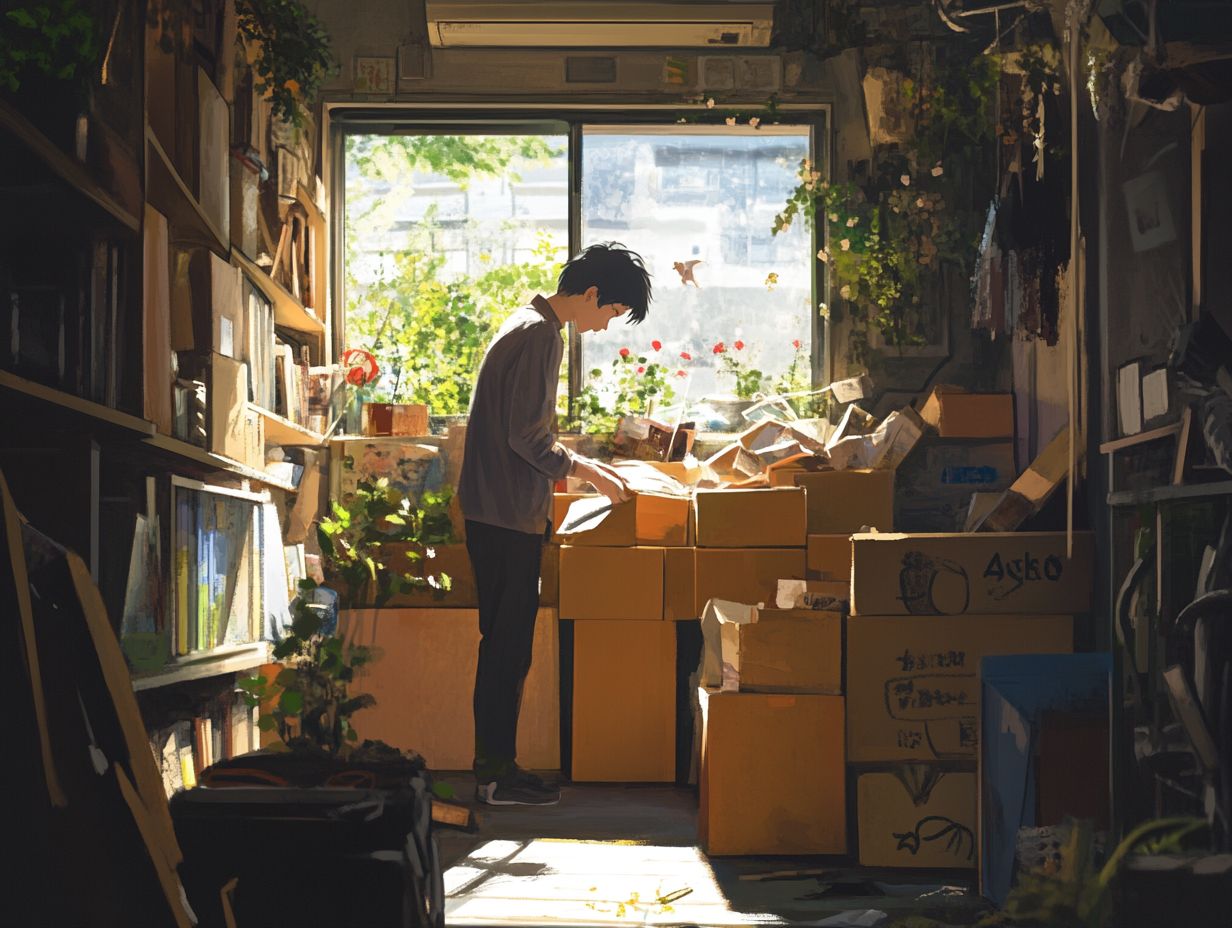
How do I determine what to keep and what to get rid of when downsizing for a tiny house?
When downsizing, carefully assess each item you own. Ask yourself if it serves a purpose or brings you joy.
What are some tips for maximizing storage space in a tiny house?
Utilize vertical space and consider investing in furniture that serves more than one purpose. Get creative with storage solutions like hanging organizers.
How can I downsize my wardrobe for a tiny house?
Start by removing items you haven’t worn in a year. Focus on versatile pieces that can be mixed and matched.
What should I do with sentimental items when downsizing for a tiny house?
Be selective with sentimental items. Take photos and create a digital memory book for those you want to remember.
How can I make the downsizing process less overwhelming?
Break the process into manageable tasks. Tackle one room or category at a time.
What are some common mistakes to avoid when downsizing for a tiny house?
Avoid keeping items out of guilt or fear. Be realistic about your space and don t acquire new items during the process.

